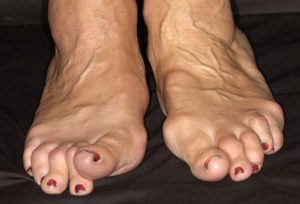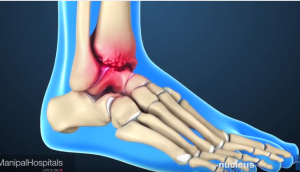The pain and stiffness you feel in your feet and ankles as you grow older could be arthritis. If left untreated, this nagging pain can grow worse, eventually becoming so excruciating that you can no longer walk even short distances. Severe arthritis can restrict your mobility and limit your quality of life, but with proper treatment, you can slow the development of arthritis and lead a more productive life.
What is Arthritis?
Arthritis is a broad term for a number of conditions that destroy the workings of a normal joint.
 Arthritis may occur in your back, neck, hips, knees, shoulders or hands, but it also occurs in your feet and ankles. Almost half of people in their 60s and 70s have arthritis of the foot and/or ankle that may not cause symptoms.
Arthritis may occur in your back, neck, hips, knees, shoulders or hands, but it also occurs in your feet and ankles. Almost half of people in their 60s and 70s have arthritis of the foot and/or ankle that may not cause symptoms.
There are many different types of arthritis. The most common type, osteoarthritis results from the “wear and tear” damage to joint cartilage (the soft tissue between joint bones) that comes with age. The result is inflammation, redness, swelling and pain in the joint.
Also, a sudden and traumatic injury such as a broken bone, torn ligament or moderate ankle sprain can cause the injured joint to become arthritic in the future. Sometimes a traumatic injury will result in arthritis in the injured joint even though the joint received proper medical care at the time of injury.
Another common type, rheumatoid arthritis, is an inflammatory condition caused by an irritation of the joint lining (the synovium). People with rheumatoid arthritis for at least 10 years almost always develop arthritis in some part of the foot or ankle.
Other types of inflammatory arthritis include gout, lupus, ankylosing spondylitis and psoriatic arthritis.
 You develop pain and limited motion so that you cannot walk as well.
You develop pain and limited motion so that you cannot walk as well.
Treatment of Arthritis of the Foot and Ankle
Proper treatment of foot and ankle arthritis addresses both pain and joint deformity. Pain develops when the joint is injured. Injury to the joint may result from swelling caused by inflammatory arthritis or from the loss of joint surface (cartilage), often caused by trauma. If left untreated, the foot and ankle may eventually become deformed.
If your doctor suspects you have arthritis of the foot and ankle, he/she will ask you to have a complete medical history and physical examination. X-rays and laboratory tests often can confirm the type and extent of the arthritis. Other tests such as a bone scan, computed tomography (CT) scan or magnetic resonance imaging (MRI) may be used to evaluate your condition.
Once your doctor confirms you have arthritis, he/she will recommend a treatment regimen which may include medications by mouth (anti-inflammatories), injections (steroids), physical therapy, weight loss, or orthotics such as pads in your shoes or custom-made braces. Surgery may be necessary. This may mean cleaning the arthritic joint, eliminating the painful motion of the joint, replacing the joint with an artificial joint or a combination of all these.
After surgery, you will require a period of rehabilitation when your foot might have to be in a cast and you might have to wear special shoes or braces for a while.




